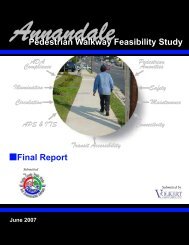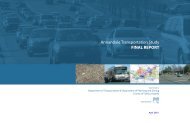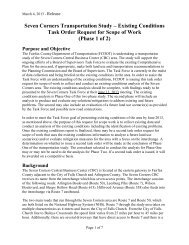2050 Eastern Gateway Concept Plan - City of Falls Church
2050 Eastern Gateway Concept Plan - City of Falls Church
2050 Eastern Gateway Concept Plan - City of Falls Church
Create successful ePaper yourself
Turn your PDF publications into a flip-book with our unique Google optimized e-Paper software.
• One TDM program could be operated for the entire study<br />
area, with a focus on the <strong>Falls</strong> <strong>Church</strong> <strong>Eastern</strong> <strong>Gateway</strong> as a<br />
common destination; the <strong>City</strong> or a third-party vendor would<br />
be responsible for managing the program. Or individual<br />
employers could operate their own TDM programs with the<br />
<strong>City</strong> or a third-party vendor providing support.<br />
• See the Metropolitan Washington Council <strong>of</strong> Government’s<br />
Commuter Connections website for more details regarding<br />
travel demand management:<br />
http://www.mwcog.org/commuter2/commuter/index.html<br />
Strategy: Provide incentives for patrons to use alternative<br />
transportation, and for developers to contribute to such<br />
improvements.<br />
• Mentioned above as a possible component <strong>of</strong> a TDM<br />
program, employers that locate within the study area could<br />
provide employees with incentives to use alternative<br />
transportation such as transit allowances or subsidies,<br />
priority parking for carpools and vanpools, or cash<br />
payments in lieu <strong>of</strong> parking spaces.<br />
• Developers could be required or incentivized, through<br />
changes to the <strong>City</strong>’s zoning code or development approval<br />
process, to contribute funding toward local transit services,<br />
or install amenities geared toward pedestrians, bicyclists,<br />
and transit riders such as showering facilities in all new<br />
buildings.<br />
• Housing developers could also be required or incentivized<br />
to provide transit subsidies to new residents, provide shuttle<br />
connections to the Metro, or contribute funding toward local<br />
transit services.<br />
Mode-Specific Recommendations<br />
Several recommendations related to promoting pedestrian<br />
activity, bicycling, and transit use are described below. A few<br />
conceptual transit routes to serve the study area are also<br />
included. These recommendations are meant to provide a basic<br />
guide as development plans move forward at the <strong>Falls</strong> <strong>Church</strong><br />
<strong>Eastern</strong> <strong>Gateway</strong>. Again, the transportation impacts and<br />
appropriate strategies to achieve the goals described<br />
previously should be further examined in future studies when<br />
detailed site plans are proposed.<br />
Pedestrians<br />
Creating a pedestrian-friendly environment yields benefits for<br />
various alternative transportation modes including bicycling and<br />
transit. Adding and improving features such as sidewalks, raised<br />
medians, bus stop placement, and pedestrian crossings will<br />
improve pedestrian safety and encourage pedestrian activity.<br />
Some features, such as medians, can improve safety for all<br />
users by enabling pedestrians to cross busy roads in two stages,<br />
controlling left-turning traffic, and slowing driver speeds. The<br />
pedestrian improvements should be made with connectivity and<br />
pedestrian circulation in mind.





